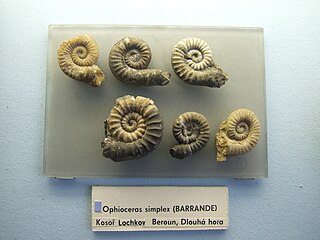The Nautilina is the last suborder of the Nautilida and the only nautiloids living since the end of the Triassic. The Nautilina, proposed by Shimanskiy, is basically the Nautilaceae of Kummel, 1964, defined by Furnish and Glenister, but differs in omitting two families, the Paracenoceratidae and Pseudonautilidae which instead are placed in the Liroceratina.
Suecoceras is an endoceratid that lived during the Middle Ordovician. It is characterised by a long, straight, slender shell with a slightly expanded tip that curves slightly downwards.

Plectronocerida is a primitive order from which subsequent cephalopod orders are ultimately derived.
The Ellesmerocerida is an order of primitive cephalopods belonging to the subclass Nautiloidea with a widespread distribution that lived during the Late Cambrian and Ordovician.
Clarkoceras is a genus of breviconic ellesmerocerid cephalopods, one of only two genera known to have crossed from the Late Cambrian, Trempealeauan, into the Early Ordovician, Gasconadian. ; the other being Ectenolites.

The Tarphycerida were the first of the coiled cephalopods, found in marine sediments from the Lower Ordovician to the Middle Devonian. Some, such as Aphetoceras and Estonioceras, are loosely coiled and gyroconic; others, such as Campbelloceras, Tarphyceras, and Trocholites, are tightly coiled, but evolute with all whorls showing. The body chamber of tarphycerids is typically long and tubular, as much as half the length of the containing whorl in most, greater than in the Silurian Ophidioceratidae. The Tarphycerida evolved from the elongated, compressed, exogastric Bassleroceratidae, probably Bassleroceras, around the end of the Gasconadian through forms like Aphetoceras. Close coiling developed rather quickly, and both gyroconic and evolute forms are found in the early middle Canadian.
Beekmanoceras is a small cephalopod from the Middle Canadian Epoch of New York with a loosely coiled, gyroconic, shell in which the whorls are not in contact and the siphuncle is on the inner or concave side of the whorl. Furnish and Glenister (1964) placed Beekmanoceras in the Trocholitidae (Tarphycerida), interpreting the curvature to be ventral side convex, i.e. exogastastric and the siphuncle to be dorsal. Flower (1964) included Beekmanoceras in the Ellesmeroceratidae believing the siphuncle to be ventral and the curvature to be endogastric with the ventral side concave.

The Ellesmeroceratidae constitute a family within the cephalopod order Ellesmerocerida. They lived from the Upper Cambrian to the Lower Ordovician. They are characterized by straight and endogastric shells, often laterally compressed, so the dorso-ventral dimension is slightly greater than the lateral, with close spaced sutures having shallow lateral lobes and a generally large tubular ventro-marginal siphuncle with concave segments and irregularly spaced diaphragms. Connecting rings are thick and layered, externally straight but thickening inwardly with the maximum near the middle of the segment so as to leave concave depressions on internal siphuncle molds. Septal necks are typically orthochoanitic but vary in length from almost absent (achoanitic) to reaching halfway to the previous septum (hemichoanitic) and may even slope inwardly (loxochoanitic).
Quebecoceras is an extinct genus from the nautiloid order Ellesmerocerida that lived during the Gasconadian Stage at the beginning of the Early Ordovician.
The Genus Hemichoanella is a small, extinct, orthoconic nautiloid cephalopod from the Lower Ordovician of Western Australia assigned to the orthoceratoid family, Baltoceratidae. Hemichoanella and the Baltoceratidae are part of the subclass of once diverse and numerous shelled cephalopods known as the Nautiloidea.
Baltoceratidae is an extinct family of orthoconic cephalopods belonging to the subclass Nautiloidea endemic to what would be Asia, Australia, Europe, North America, and South America during the Ordovician living from about 480–460 mya, existing for approximately 20 million years.

Pseudorthoceratidae is an extinct family of actively mobile aquatic carnivorous cephalopods belonging to the subclass Orthoceratoidea endemic to what would be North America, Asia, and Europe during the Silurian living from 460.5—251 Ma, existing for approximately 209.5 million years.
Cyptendoceras is an extinct nautiloid cephalopod included in the family Ellesmeroceratidae that lived in what would be North and South America during the latter part of the Early Ordovician from about 475 – 472 mya, existing for approximately 3 million years.
Donacoceras is an extinct genus of actively mobile carnivorous cephalopod, essentially a Nautiloid that lived in what would be North America during the Ordovician from 460.5—443.7 mya, existing for approximately 16.8 million years.
Basslerocerida is an order of nautiloid cephalopods from the Ordovician comprising exogastric longiconic cyrtocones, that is no longer in common use.
Lobendoceras is a proterocameraceratid with a rather large, moderately expanded, straight shell with a large marginal siphuncle in which sutures have a broad, deep, ventral lobe and septal necks are subholochoanitic to holochoanitic.
Dakeoceras is a genus of simple cyrtoconic ellesmeroceratid cephalopods in the fossil record. All known species come from the Lower Canadian epoch (Gasconadian) of North America.

Ophioceras is a genus of closely coiled tarphycerid nautiloid cephalopods, the sole representatives of the family Ophidioceratidae, characterized by an evolute shell with narrow, subrounded, annulated whorls and a subcentral siphuncle composed of thin connecting rings that show no evidence of layering. The mature body chamber is strongly divergent and is the longest proportionally of any tarphycerid. The aperture has a deep hyponomic sinus and ocular sinuses, and so resembles some lituitids.
Hectoceras is a genus in the nautiloid cephalopod order Discosorida from the Upper Ordovician of Australia (Tasmania), known from a few isolated siphuncle specimens.
Apocrinoceratidae constitutes a family of Middle Ordovician nautiloid cephalopods characterized by straight or slightly curved, transversely ribbed shells having siphuncles composed of expanded segments, short recurved septal necks, and thick connecting rings. Derivation is from the Protocycloceratidae, a family of ellesmerocerids, which differ in having straight or concave siphuncle segments, but are otherwise similar in form.




